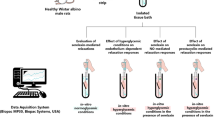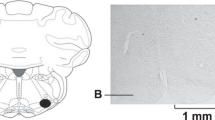Abstract
The mechanism by which yohimbine relaxes the human corpus cavernosum remains unclear. Using the human corpus cavernosum strips immersed in isometric baths containing Krebs–Henseleit solution, this study investigates the effect of yohimbine on the relaxation of the human corpus cavernosum through nitrergic pathways involving the activation of ATP-dependent potassium channels (KATP). The maximal relaxation induced by yohimbine in the human corpus cavernosum strips pre-contracted with phenylephrine was 100±0% and only 30.5±5.0% when they were pre-contracted with 60-mM potassium (K+) solution. The maximal relaxation induced by yohimbine in phenylephrine pre-contracted tissues was significantly inhibited by tetrodotoxin, 1H-[1,2,4] oxadiazolo[4,3-a]quinoxalin-1-one (ODQ) or 7-nitroindazole (43.6, 36.1 and 42.6%, respectively). Neither the combination charybdotoxin–apamin nor tetraethylammonium altered the response of the human corpora cavernosa strips to yohimbine. Nevertheless, glibenclamide decreased the maximum relaxant response to yohimbine by 29.8% (P<0.05; n=12). The results suggest that yohimbine relaxes the human corpus cavernosum by a non-adrenergic, non-cholinergic mechanism, probably activating the nitrergic-soluble guanylate cyclase (NO-sGc) pathway and KATP.
This is a preview of subscription content, access via your institution
Access options
Subscribe to this journal
Receive 8 print issues and online access
$259.00 per year
only $32.38 per issue
Buy this article
- Purchase on Springer Link
- Instant access to full article PDF
Prices may be subject to local taxes which are calculated during checkout



Similar content being viewed by others
References
Feldman HA, Goldstein I, Hatzichristou DG, Krane RJ, McKinlay JB . Impotence and its medical and psychosocial correlates: results of the Massachusetts Male Aging Study. J Urol 1994; 15: 54–61.
Andersson KE, Wagner G . Physiology of penile erection. Physiol Rev 1995; 75: 191–236.
Fallon B . ‘Off-label’ drug use in sexual medicine treatment. Int J Impot Res 2007; 20: 127–134.
Filippi S, Luconi M, Granchi S, Natali A, Tozzi P, Forti G et al. Endotheliumdependency of yohimbine-induced corpus cavernosum relaxation. Int J Impot Res 2002; 14: 295–307.
Traish A, Gupta S, Gallant C, Huang Y-H, Goldstein I . Phentolamine mesylate relaxes penile corpus cavernosum tissue by adrenergic and non-adrenergic mechanisms. Int J Impot Res 1998; 10: 215–223.
Tam SW, Worcel M, Wylle M . Yoimbine: a clinical review. Pharmacol Ther 2001; 91: 215–243.
Glina S, Martins FG, Damião R . Tratamento oral. In: I Consenso Brasileiro de disfunção erétil (ed). BG cultural. Rio de Janeiro, Brazil, 1998, pp, 63–70.
Stanislavov R, Nikolova V, Rohdewald P . Improvement of erectile function with Prelox: a randomized, double-blind, placebo-controlled, crossover trial. Int J Impot Res 2007; 20: 173–180.
Traish AM, Moreland RB, Huang YH, Goldstein I . Expression of functional α2- adrenergic receptor subtypes in human corpus cavernosum and in cultured trabecular smooth muscle cells. Recept Signal Transduct 1997; 7: 55–67.
Kim NN, Goldstein I, Moreland RB, Traish AM . Alpha-adrenergic receptor blockade by phentolamine increases the eficacy of vasodilators in penile corpus cavernosum. Int J Impot Res 2000; 12 (Suppl 1): S26–S36.
Silva LF, Nascimento NR, Fonteles MC, de Nucci G, Moraes ME, Vasconcelos PR et al. Phentolamine relaxes human corpus cavernosum by a non-adrenergic mechanism activating ATP-sensitive K+ channel. Int J Impot Res 2005; 17: 27–32.
Hellstrom WJG . Clinical applications of centrally acting agents in male sexual dysfunction. Int J Impot Res 2008; 20: S17–S23.
Senbel AM, Mostafa T . Yohimbine enhances the effect of sildenafil on erectile process in rats. Int J Impot Res 2008; 20: 409–417.
Saenz de Tejada I, Garvey DS, Schroeder JD, Shelekhin TL, Letts G, Fernandez A et al. Design and evaluation of nitrosylated α-adrenergic receptor antagonists as potential agents for the treatment of impotence. Pharmacol Exp Ther 1999; 290: 121–128.
Saenz de Tejada I . Molecular mechanisms for the regulation of penile smooth muscle contractility. Int J Impot Res 2002; 14 (Suppl 1): S6–S10.
Molderings GJ, Göthert M, Van Ahlen H, Porst H . Noradrenaline release in human corpus cavernosum and its modulation via presynaptic alpha 2-adrenoceptors. Fundam Clin Pharmacol 1989; 3: 497–504.
Saenz De Tejada I, Kim NN, Goldstein I, Traish AM . Regulation of pre-synaptic alpha-adrenergic activity in the corpus cavernosum. Int J Impot Res 2000; 12 (Suppl 1): S20–S25.
Archer SL . Potassium channels and erectile dysfunction. Vasc Pharmacol 2002; 38: 61–71.
Spector M, Rodriguez R, Rosenbaum RS, Wang HZ, Melman A, Christ GJ . Potassium channels and human corporeal smooth muscle cell tone: further evidence of the physiological relevance of the maxi-K channel subtype to the regulation of human corporeal smooth muscle tone in vitro. J Urol 2002; 167: 2628–2635.
Stumpff F, Strauss O, Boxberger M, Wiederholt M . Characterization of maxi-channels in bovine trabecular meshwork and their activation by cyclic guanosine monophosphate. Invest Ophthalmol Vis Sci 1997; 38: 1883–1892.
Fanh SF, Brink PR, Melmann A, Christ GJ . An analysis of the Maxi-K+ (Kca) channel in cultured human corporal smooth muscle cells. J Urol 1995; 153: 818–825.
Venkateswarlu K, Giraldi A, Zhao W, Wang HZ, Melman A, Spektor M et al. Potassium channels and human corporeal smooth muscle cell tone: diabetes and relaxation of human corpus cavernosum smooth muscle by adenosine thiphosphate sensitive potassium channel operners. J Urol 2002; 168: 355–361.
El-Metwally MA, Sharabi FM, Daabees TT, Senbel AM, Mostafa T . Involvement of alpha-receptors and potassium channels in the mechanism of action of sildenafil citrate. Int J Impot Res 2007; 19: 551–557.
Campos AR, Cunha KMA, Santos FA, Silveira ER, Uchoa DEA, Nascimento NRF, Rao VSN . Relaxant effects of an alkaloid-rich fraction from Aspidosperma ulei root bark on isolated rabbit corpus cavernosum. Int J Impot Res 2007; 20: 255–263.
Author information
Authors and Affiliations
Corresponding author
Rights and permissions
About this article
Cite this article
Freitas, F., Nascimento, N., Cerqueira, J. et al. Yohimbine relaxes the human corpus cavernosum through a non-adrenergic mechanism involving the activation of K+ATP-dependent channels. Int J Impot Res 21, 356–361 (2009). https://doi.org/10.1038/ijir.2009.41
Received:
Revised:
Accepted:
Published:
Issue Date:
DOI: https://doi.org/10.1038/ijir.2009.41
Keywords
This article is cited by
-
Relaxant effect of a metal-based drug in human corpora cavernosa and its mechanism of action
International Journal of Impotence Research (2016)



